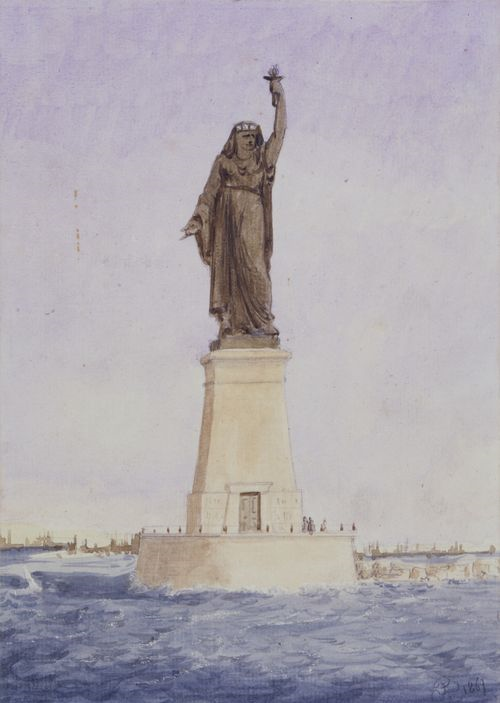She has pretty well much displaced the former personification of the United States, Colombia, entirely; so much so that Colombia doesn't even appear on coinage anymore but Lady Liberty does appear on the unpopular One Dollar coin.
With this currently Presidential campaign becoming more like a dog and pony show every day; with one particular candidate even calling for a new Great Wall to be erected between the United States and Mexico, it kind of makes the words on the plaque at the base of the Statue of Liberty ring a little hollow. The same sort of sentiment which ensured Lady Liberty be the last thing that new immigrants saw before they made their way to Ellis Island, might not exist today as America again turns a little isolationist.
"Keep, ancient lands, your storied pomp!" cries she
With silent lips. "Give me your tired, your poor,
Your huddled masses yearning to breathe free,
The wretched refuse of your teeming shore.
Send these, the homeless, tempest-tost to me,
I lift my lamp beside the golden door!"
Could those words be written today? Would they be extended if a Muslim were to arrive?
The story of the Statue of Liberty herself is a curious tale. Even though she would have overseen the arrival of thousands of different immigrants from a whole host of countries, it worth remembering that the Statue of Liberty herself as originally designed would have had a headscarf.
She would have been an Egyptian peasant lady or a "fellah" and was intended to act as a lighthouse for the new canal. This never happened.
Isma'il Pasha who was the Khedive of Egypt and Sudan from 1863 to 1879, finally did see the opening of the Suez Canal in November 17, 1869. The construction of the canal did not go well and shares in the company which owned it, was under-subscribed. The ensuing financial crisis which meant that the Egyptian Government effectively had to underwrite the project, meant that funds for decorations such as a new colossus had to be shelved. When primary customer France entered into a war with Prussia in 1870, the plans were dropped entirely.
Her designer Frédéric Auguste Bartholdi was so distraught at the news that she would not be overseeing this marvel of engineering that he kind of went crazy trying to find her a home. When the Governor of New York questioned him, he vehemently denied that the statue was ever intended to go to Egypt and rumours started to fly around in the press that he'd modelled the face either on his mother or his brother who had committed suicide.
Somehow Bartholdi convinced French politician Édouard René de Laboulaye who was an anti-slavery activist, that the statue should be re-purposed and given to the people of America as a gift. Again the project ran into funding issues and Bartholdi took out a patent on models of the statue before it was built and even convinced newspaper publisher Joseph Pulitzer to publish names of the people who had donated to its construction in his daily newspaper the The New York World. Most of the people who had their names published in the newspaper had donated less than one dollar.
After her arm was displayed at the 1776 Centennial Exposition in Philadelphia and her head went on display at the 1878 Paris World's Fair, construction moved slowly until she was finally unveiled to the world by President Grover Cleveland on October 28, 1886.
The other thing I found interesting to think about was that for the first 25 years or so of her existence because she is made of hammered copper plates (and incidentally generates an amazing amount of static electricity), she wouldn't have been the green colour that we usually think of her being but she would have been the same colour as an American penny - brown.
So how about that? Not only was the original intent for the Statue of Liberty to be an Egyptian peasant lady with a headscarf but she was originally coloured brown and a Muslim. She was even crowdfunded and the subject of a patent. Originally intended for Egypt, she became an immigrant to the United States, oversaw and came to symbolise the hopes and dreams of thousands and thousands of other immigrants.
I wonder what would happen to someone matching her description if they arrived at the US border today? Send these, the homeless, tempest-tost to me?


No comments:
Post a Comment